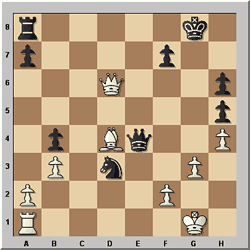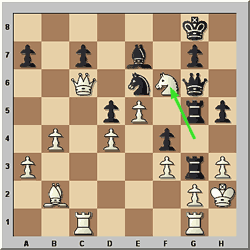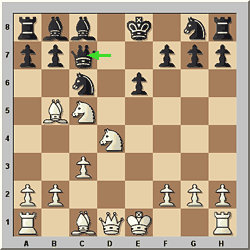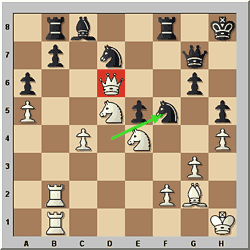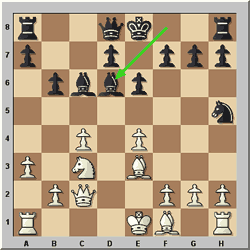 The
chess duel Man vs Machine, Vladimir Kramnik vs Deep Fritz is being staged from
November 25 until December 5th. It is sponsored by the RAG
AG, one of Europe's largest energy companies. The venue is the National
Art Gallery in Bonn, Germany. Schedule:
The
chess duel Man vs Machine, Vladimir Kramnik vs Deep Fritz is being staged from
November 25 until December 5th. It is sponsored by the RAG
AG, one of Europe's largest energy companies. The venue is the National
Art Gallery in Bonn, Germany. Schedule:
| Game 1: |
Saturday |
25.11.2006 |
15:00 h |
| Game 2: |
Monday |
27.11.2006 |
15:00 h |
| Game 3: |
Wednesday |
29.11.2006 |
15:00 h |
| Game 4: |
Friday |
01.12.2006 |
15:00 h |
| Game 5: |
Sunday |
03.12.2006 |
15:00 h |
| Game 6: |
Tuesday |
05.12.2006 |
15:00 h |
There is full live coverage on the Playchess
server, as well as on the official
site and a number of partner sites.
Game two – the missed mate
After the mate-in-one
blunder by Vladimir Kramnik in game two of his match against Deep Fritz
10 in the Man vs Machine match, and our attempted
explanation of the mechanics of the blunder, we have received a number
of interesting letters on the subject. We bring you a selection, and then a
small collection of similarly inexplicable blunders by world champions or world
championship candidates. We do this with apologies to Vladimir Kramnik, who
has probably heard enough about the subject.
First the readers' feedback
Yannick Roy of Montréal, Canada
Interesting but not entirely satisfactory answer. Of course it is true that
the knight protecting the h7 square being on the 8th rank is a rare configuration,
seen more often in composed problems than in actual games, but still... It's
quite simple to see, and I'm sure it takes less than the fraction of a microsecond
for a player of Kramnik's calibre to spot it.
Somehow I feel a more general explanation, linked to the type of stress a
match against a computer puts on a human player, might be in order. Being on
the razor's edge for a few hours, calculating variations endlessly, probably
makes the pieces dance in front of one's eyes. The only other type of explanation
I can think of would be of a psychoanalytical nature; maybe somehow, subconsciously,
Mr. Kramnik wanted to lose the game, or even embarrass himself in
front of the chess world, out of repressed guilt or something. But of course
that will have to be dealt with between Mr. Kramnik himself and his analyst,
if he has one (or if he seeks one after this blunder). I can't help but notice,
however, that he also made a blunder (although not nearly as spectacular as
this one) during his 2002 match in Bahrain, just around move 35. Is it something
with that number? Is that what it's all about? Who knows. One thing at least
is clear; the human brain remains, for better or for worse, much more complicated
than a silicon chip.
John Rood, Holbrook, MA, USA
I liked your "cognitive psychology" explanation of Kramnik's blunder.
I found it convincing. I wish to add one more factor that might have contributed
to missing the mate. The knight had just arrived at the key square by a very
natural, apparently innocuous, manner, namely the capture of a piece in an
exchange of material. Thus Kramnik might not have had any "suspicions"
of its position being crucial for a hidden mate.
Andreas, Thyrhaug, Stockholm, Sweden
How about letting people vote, hopefully honestly, if they missed 35.Qh7 mate,
or not, before it was executed on the board? I will vote "No, I honestly
did not see 35.Qh7 mate before it was executed on the board." Like Kramnik
and many others I was also looking at the pawns on the queenside. I just froze
to ice when 35.Qh7 mate was played. I thought something must have gone wrong
with the input on the official web site, and that this position was not actually
on the real board. I think the statistics of how many people missed it would
be interesting! The result of the game is not important. The widened insight
into how the human brain recognize patterns was worth more than a million dollars!
Zak Seidov, Ashkelon, Israel
I like your comment on this blunder of the millenium and the explanation given
by Alexander Roshal, who told us that the mating pattern that occurred during
the game, with the white queen protected by a knight on f8 is extremely rare
in chess. I must say that being some 2400 (Playchess blitz Elo) player I didn't
see mate during the transmission! But my explanation is not that the "mate
construction" was unusual or rare in chess. The problem was that during
the last (rather forced) several moves before mate White wasn't at all trying
or threatening to mate, but rather to achieve a draw! The move 34.Nxf8 was
not aiming at mate but was the only move to restore material balance. And this
was in minds of all human beings including Vlad and me...
Tobias Nordquist, Sandviken, Sweden
I had a similar experience. In a blitz game I was white and had in a wild position
taken a bishop on g4 with Ne5xg4. My move was a little bit clumsy and the piece
landed a little bit betwen g4 and g5. Anyway it was a blitz game swop swop,
and in my mind the Knight was on g5. At some moment I played Qd3, and then
Qh7 mate (I was sure). My oponent looked at me and then at the knight betwen
g4 and g5. He "corrected" it to g5, saying "I didn't see the
knight". I have thought about this incident many times, and was reminded
of it by Kramnik's blunder.
Kyle Morrison, Waterloo, Canada
In the article regarding how Kramnik could have missed the mate in 1, it was
mentioned as an example of chess pattern blindness that GM Yasser Seirawan
missed it as well. It was said in the article that Seirawan, after ...Qe3,
started discussing White's possibilies, all except mate in 1. This is in fact
not true. I was listening to the live broadcast, and before the move had even
been relayed to the net (both the ChessBase and Spiegel online sites), Seirawan
was shouting into the microphone "Oh my God, oh my God, Kramnik has blundered!"
This is just a point of information, that Seirawan spotted it right away.
Andrew Pressburger, Toronto, Canada
Because in the entirely fortuiotus realm of human affairs we cannot
know what happens from one minute to the next. Our existence is merely a series
of hopeful yet blind guesses. So much for Aristotelian logic. Bah, humbug!
Brian Carson, Toronto
When we watch Kramnick play, we see a man confident that he can play as capably
and subtly as the machine. In his own mind he is confident that he has proven
his skill as equal or better. Was his slip overlooking a mate in one in Bonn,
just simply proof that men get tired and machines do not. Or is this Kramnik's
way of fighting to beat the machine in the next game as white and keep it all
terribly dramatic, or conversely, does this just prove the global and commonly
held the belief that all this is rigged to assure big sales of the ChessBase
product line? I dare you to print this legitimate question.
Mark Baldock, London, UK
Your news report provided a picture of the stage including the wide screen
installed in the auditorium. The screen detailed the variations Fritz 10 was
considering at that particular time along with its evaluation. Please forgive
me in case I am missing something, but what is to stop Kramnik just looking
at the screen to see what Fritz 10 is thinking and play accordingly?
The screen shots of the Deep Fritz 10 display were taken from a balcony
on the opposite side from Kramnik. He could not of course see the computer screen
during the game (except in the opening phase, as agreed in the rules). Naturally,
viewing the thought process of the computer during the game would make it
meaningless. Even a chess amateur could otherwise play against Fritz, by
simply executing the move the computer is displaying in the main line. –
Ed.
Levon Bagramian, New York, NY
I've been reading your wonderful news section for a long time now, and on some
items I always felt the need to comment or add a newsworthy bit of info. This
need became most apparent with the latest sensation: Kramink's overlooking
the mate in one. Would it be too much to add a section under every news item
for comments? Most respected news sites have it nowadays. I believe it'll add
a nice level of interaction to your pages. And I believe your readership is
mature and concerned enough to not allow that feature to turn into a rant-all-you-can
section.
Arnel De Castro, Iloilo
The recent 2006 Man versus Machine match is very interesting. However, the
computer doesn't get tired and is very consistent in its calculations, all
through out the match. The blunder of Kramnik in game two was due to stress
during his calculation of his previous moves. Perhaps in the future matches
of Man vs Machine, humans should be given one take-back move for every game
to compensate this weaknesses. It would be interesting also if you feature
an article with insights from psychologists or other medical experts why humans
buckle under too much pressure against a computer in a chess match. And –
thank you for bringing Chess news, ChessBase!
The idea of one (or a few) takebacks is not completely outlandish. In
fact it was once suggested by GM Susan Polgar for computer games. The reasoning
is: do we want to measure the stamina of humans as opposed to computers,
or the chess skills and comprehension? In an experiment to just test the
latter it might be expedient to introduce rules to eliminate the former.
– Ed.
Martin Raschti, Germany
Regarding Kramnik's ... Qe3 error I'd like to point you to the funny coincidence
that the second game (!) of the Kasparov vs. Deep Blue match in 1997 also famously
featured a human mistake based on the move ...Qe3 – which would've saved
Kasparov through perpetual check, when he instead resigned.
Stig Martinsen, Bergen, Norway
Alexander Roshal's explanation in terms of the missing pattern (rare
with the knight on f8) sounds right. However, if the mate had been White's
only idea in the position, I think Kramnik would have seen it immediately.
When Kramnik saw the perpetual check idea several moves before, he must have
prematurely and subconsciously have decided that this was White's only
idea (a very common cause of blunders, in fact). Perhaps he was also influenced
by the perception that White is fighting for a draw, not for a win. It is with
some Schadenfreude an amateur observes that even World Champions could benefit
from following Blumenfeld's Rule: before moving, stop and look at the board
afresh, "through the eyes of a patzer".
Julio Mendoza-Medina, Kentucky, USA
I have to disagree with Mr. Alexander Roshal's explanation. Although
it sounds convincing, I think that GMs (and Vladimir Kramnik is a very strong
one) are used to see patterns one way or the other way around. That story of
the knight on an unusual position is just funny. What sometimes happens –
please remember we are humans – is one of these (or both):
1. Kramnik simply overlooked the mate threat because he was very busy
with his plans on the queenside. Period. He did not even consider in his mind
what was White's threat.
2. Kramnik forgot to make the move to take care of the mate threat first.
Often times you consider or see the threat, and you know you have to make that
very move that stops it, but unexpectedly you make the move you had in your
mind to do next.
Janis, Nisii, Rome, Italy
Alexander Roshal's theory on the reasons why Kramnik overlooked a mate in one
during his game two against Fritz 10 is very interesting, and also somehow
convincing. However, it seems to me that Mr. Roshal got a bit carried away
by his own reasoning. I don't reckon that the mate pattern that occurred during
the game could be considered as 'unusual' or 'weird', let alone the last two
screen shots that shows two patterns that, according to Roshal, would have
recognised as mating patterns. I do believe that Kramink wouldn't never have
played 34...Qe3 in those positions, but not on account of the mating pattern,
rather because of the hanging knight!
IM John-Paul Wallace, London England
I read with interest the opinions of how Kramnik could allow a mate
in one. In my opinion it is most likely a combination of factors. As Roshal
says a Nf8 and Qh7 mate is rare, but I think it is more than that. Firstly
I would say that for sure if Fritz did not take something on f8, if
he just moved his knight there, then Kramnik would see the mate instantly.
He would ask the purpose of the move. As it was he simply thought
the purpose was recapturing a piece. Also, psychologically, Kramnik had been
pressing in this game, and this clouds one's human mind, one loses some objectivity.
Well done on a great website!
Louis Morin, Montreal, Canada
If the computer had played Nf8 (a quite unusual move for a white knight), a
bell would have rang in Kramnik's head and the mating threat would have been
very obvious. But since the computer played N takes f8 (a very obvious
and predictable move, capturing the unprotected rook to maintain material equality),
no bell rang in Kramnik's head and the mating threat went completely unnoticed.
Jim Thompson, Helton, USA
Monday's one-mover by Fritz over Kramnik made me wonder how many world champions
have been mated during their reigns. Counting the 14 from Steinitz to Kramnik,
here is what I found, using Fritz 9: Steinitz, Lasker, Capablanca, Alekhine,
Botvinnik, Smyslov, Tal, Petrosian, Spassky and Karpov were never mated in
a serious game, while they were world champions. Neither was Fischer, but then
he never played a game while officially world champion!
Max Euwe is the only world champion to have lost a serious tournament game
by mate. That was in 1937, when he blundered in a lost position in the fifth
round of the Bad Naumheim tournament against Bogoljubow. Kasparov was mated
in a blitz game by Kiril Georgiev in the World Championship Blitz at Saint
John in 1988. He was never mated in a game at classic time controls. In December
2001, in the Botvinnik Memorial 5 minute blitz tournament, Kramnik was mated
-- by Kasparov! And that is the list, as far as I could determine.
Lola Ice, Boulder, Colorado
I would like to know how many times in his chess career has Kramnik been mated.
In general how often do Grandmasters fall prey to mate? If it is possible please
mention these stats in a future article concerning this most unusual loss.
GM John Nunn, London, GB
I don't know if anyone has pointed it out, but the missed mate in 1 bears some
resemblance to the following game:
Wells,Peter K (2480) - Areshchenko,Alexander (2640) [E06]
Monarch Assurance Isle of Man (4), 2006
1.d4 d5 2.Nf3 Nf6 3.c4 c6 4.Nc3 e6 5.g3 Be7 6.Bg2 0-0 7.0-0 b6 8.Ne5
Bb7 9.e4 dxc4 10.Nxc4 Ba6 11.b3 b5 12.Ne3 b4 13.Ne2 Nbd7 14.Bb2 Nb6 15.Re1
Rc8 16.Nf4 Re8 17.h4 Bb7 18.Ng4 Nbd7 19.d5 cxd5 20.exd5 exd5 21.Bxd5 Bxd5 22.Nxd5
Nxd5 23.Qxd5 Nc5 24.Qf5 Qd3 25.Qf4 h5 26.Nh6+ gxh6 27.Rxe7 Rxe7 28.Qf6 Qh7
29.Qxe7 Nd3 30.Qd7 Ra8 31.Bd4 Qe4 32.Qd6
32...Ne1 33.Bb2 Qg2# 0-1.
Famous blunders
The following examples were collected by Johannes Fischer, chess historian
and writer.
Staunton,Howard - Anderssen,Adolf [C54]
London knockout London (3.4), 1851
1.e4 e5 2.Nf3 Nc6 3.Bc4 Bc5 4.c3 Nf6 5.d4 exd4 6.e5 d5 7.Bb5 Ne4 8.cxd4
Bb4+ 9.Nbd2 0-0 10.0-0 Bg4 11.Bxc6 bxc6 12.Qc2 Bxf3 13.Nxf3 Rb8 14.Qxc6 Rb6
15.Qc2 f5 16.a3 Be7 17.b4 f4 18.Ne1 Rh6 19.f3 Ng5 20.Nd3 Ne6 21.Bb2 Qe8 22.Rac1
Qh5 23.h3 Rg6 24.Nf2 Rg3 25.Kh2 Rf5 26.Qc6 Qg6 27.Rg1 Rfg5 28.Ng4 h5 29.Nf6+
After the last move Staunton was actually lost, since after 29...Bxf6 30.Qxe6+
Kh7 White cannot defend the g2 square. But Adolf Anderssen played 29...Kf7??
One of the greatest masters of 19th century chess, renown for his sparkling,
tactical play, had overlooked 30.Qe8#.
Steinitz,Wilhelm - HG Voight [B29]
Philadelphia, 01.12.1885
1.e4 c5 2.Nc3 Nc6 3.Nf3 Nf6 4.e5 Ng8 5.d4 cxd4 6.Nxd4 e6 7.Ne4 d5
8.exd6 Bxd6 9.Bb5 Qd7 10.c3 Bb8 11.Nc5 Qc7
One year before becoming the first official world champion in the history
of the game Wilhelm Steinitz, in the above position, decided to bring his king
into "safety": 12.0-0?? Unfortunately he had overlooked
the long diagonal threat of Black's previous moves. The result: 12...Qxh2#
0-1.
Petrosian,Tigran V - Bronstein,David I [E65]
Candidates Tournament Amsterdam (2), 1956
1.c4 Nf6 2.Nc3 g6 3.g3 Bg7 4.Bg2 0-0 5.Nf3 c5 6.0-0 Nc6 7.d4 d6 8.dxc5 dxc5
9.Be3 Nd7 10.Qc1 Nd4 11.Rd1 e5 12.Bh6 Qa5 13.Bxg7 Kxg7 14.Kh1 Rb8 15.Nd2 a6
16.e3 Ne6 17.a4 h5 18.h4 f5 19.Nd5 Kh7 20.b3 Rf7 21.Nf3 Qd8 22.Qc3 Qh8 23.e4
fxe4 24.Nd2 Qg7 25.Nxe4 Kh8 26.Rd2 Rf8 27.a5 Nd4 28.b4 cxb4 29.Qxb4 Nf5 30.Rad1
Nd4 31.Re1 Nc6 32.Qa3 Nd4 33.Rb2 Nc6 34.Reb1 Nd4 35.Qd6 Nf5
Tigran Petrosian, world champion from 1963 to 1969, was one of the most solid
players the game has known. In this game he was not in time trouble, but calmly
played 36.Ng5?? losing his queen in one move: 36...Nxd6
0-1.
Huebner,Robert (2600) - Korchnoi,Viktor (2695) [C09]
Candidates final Merano (7), 1980
1.e4 e6 2.d4 d5 3.Nd2 c5 4.exd5 exd5 5.Bb5+ Nc6 6.Ngf3 cxd4 7.Qe2+
Qe7 8.Nxd4 Qxe2+ 9.Kxe2 Bd7 10.N2f3 Nf6 11.Re1 Nxd4+ 12.Nxd4 0-0-0 13.Bd3 Bc5
14.c3 Rde8+ 15.Kf1 Rxe1+ 16.Kxe1 Ng4 17.Bf4 f6 18.Rd1 Ne5 19.Bc2 Bxd4 20.Rxd4
Be6 21.f3 h6 22.Kf2 Rd8 23.Rd1 Kd7 24.Re1 Nc4 25.h4 a6 26.Bg6 Rc8 27.g4 Rc6
28.Re2 b5 29.h5 a5 30.Bd3 Rb6 31.b3 Nd6 32.Rc2 Nf7 33.Be2 Ne5 34.Rd2 Kc6 35.Kg3
Rb7 36.Be3 Nf7 37.Bd4 Rb8 38.Bf1 Kc7 39.Kf4 Nd8 40.Bd3 Bd7 41.Kg3 Ne6 42.Bf2
a4 43.Bc2 axb3 44.axb3 Kd6 45.Be4 Bc6 46.Be3 Ra8 47.c4 bxc4 48.bxc4 d4 49.Bxd4
Bxe4 50.Bxf6+ Kc5 51.Be7+ Kxc4 52.fxe4 Ra7 53.Bd6 Ng5 54.Kf4 Rf7+ 55.Ke3 Rf3+
56.Ke2 Rf7 57.Be5 Nf3 58.Rc2+ Kb5 59.Ba1 Nh2 60.Kd3 Nxg4 61.Rg2 Rf3+ 62.Kd4
Rf4
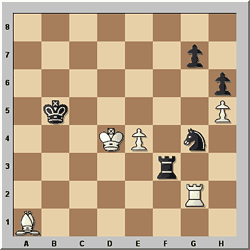
In the above position Germany's top grandmaster and four times world championship
candidate thought for a long time and then played 63.Kd5??
Hübner, who at the time was number three in the world (after Karpov and
Korchnoi) overlooked the simple fork 63...Ne3+ 0-1. It was
the seventh game of sixteen to be playind the Candidates Match in Mirano, and
Hübner had been leading 2:1. He lost game eight as well, and retired from
the match with the next two games adjourned (both were awarded to Korchnoi).
Shortly thereafter the above position was the subject of a very cruel title
picture of the German TV guide Hör Zu. However this is probably
lost to posterity.
Christiansen,Larry Mark (2620) - Karpov,Anatoly (2725) [E12]
Hoogovens Wijk aan Zee (2), 01.1993
1.d4 Nf6 2.c4 e6 3.Nf3 b6 4.a3 Ba6 5.Qc2 Bb7 6.Nc3 c5 7.e4 cxd4 8.Nxd4
Nc6 9.Nxc6 Bxc6 10.Bf4 Nh5 11.Be3 Bd6
The twelfth world champion and one of the greatest tournament players of all
times overlooked a simple (but long-distant) fork: 12.Qd1
attacking the bishop and the knight on h5. Karpov resigned immediately.
Links
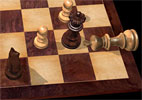

















 The
chess duel Man vs Machine, Vladimir Kramnik vs Deep Fritz is being staged from
November 25 until December 5th. It is sponsored by the
The
chess duel Man vs Machine, Vladimir Kramnik vs Deep Fritz is being staged from
November 25 until December 5th. It is sponsored by the 